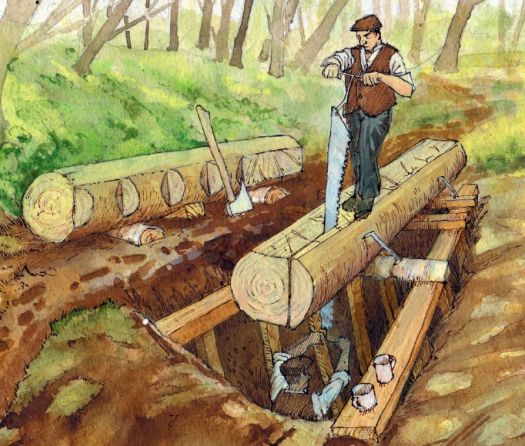Saw Pit
Saw pits are trenches over which timber is positioned to be sawed with a long-handled saw ("whipsaw"), commonly in tandem between two workers. The worker in the pit was termed the "underdog" and the worker on top the "topdog." The result is sawn planks for construction, especially shipbuilding. In backcountry parts, saw pits were dug in order to saw trees before shipment, but many manufacturing towns, villages or country estates have their own saw pits.
"Sawyers," handling the crucial work of turning timber into useful wood, are important members of a community, as the manufacture of implements and buildings depend on them. Some 12 boards a day can be made by two men in a saw pit. A pit can be worked by a single person, with the end of the saw being weighted with a stone, but this lowers the number of boards that can be managed in a day to 4 or 5. Saw pits are replaced by water-powered mills, which can cut up to 200 boards a day, in manufacturing towns.
Saw pits only occur in regions where trees are available. If nearby wilderness hexes are barrens, desert or steppe, no saw pit will be present.
The pit is easy to build and can be made ready in a few days.
Population
Saw pits are supported by woodcutters, who gather wood and bring it to the saw pit. Although the woodcutters are less likely to dwell within thorp, hamlet or larger settlement, their presence counts towards the population that a saw pit contributes. Woodcutters and their families number only 2-4 persons. Typically, the saw pit is also run within a family, by parent-offspring or by siblings: this contributes another 2-5 persons. Therefore, the population supported by a saw pit is 4-9.
See also,
Hammer (symbol)
The Adventure
Type-7 Hex
